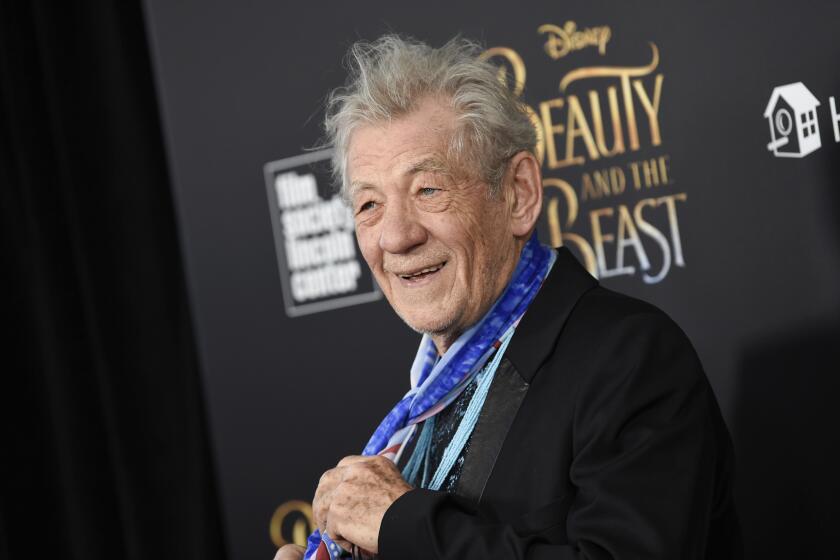Math made lively
With exceptional geometric abstractions now regularly being made by younger painters as diverse as Darcy Huebler, Bart Exposito and Yek, it was inevitable that artists of an earlier generation would begin to be reassessed. One provocative and engaging example is “June Harwood: California Hard Edge Painting Revisited, 1959-1969,” a newly opened exhibition at NoHo Modern.
NoHo Modern, a mid-century furnishings emporium with aspirations to establish a serious gallery program, has assembled 17 mostly untitled paintings (and one small painted sculpture) for a debut exhibition. The paintings span the decade in which Harwood developed a mature and independent style.
As oil paint and Masonite give way to plastic-based acrylics and canvas in her work, rectilinear planes of dark and light evolve into colored fields of curved space. Following the trajectory of these paintings is rather like watching tectonic plates begin to shift, break apart and slowly bend beneath unseen forces of unstoppable pressure -- rather like the unfolding decade of the 1960s itself.
Harwood, who taught for many years at Los Angeles Valley College before her recent retirement, is a second-generation Hard Edge painter. The term -- coined in 1959 by her late husband, the eminent art critic Jules Langsner, for an older group of painters that famously included John McLaughlin and Lorser Feitelson -- marked the first episode of international success for postwar Los Angeles art. The aesthetic helped to spawn directions as disparate as the perceptual environments of Robert Irwin’s Light and Space art and the epistemological sculptures of Bruce Nauman.
The show’s earliest painting, from 1959, is a handsome vertical abstraction in flat, velvety shades of black, gray and teal blue. Perceptually, a subtle grid is established. Black and gray rectangles bisect the panel’s bottom edge, while the top edges of those rectangles cut the picture in two across the center. (Think of mullions dividing a window.) Interlocking L-shapes are dominant in the top half.
The intimation of a grid plays quietly against the actual, hand-rendered shapes, few of which are strictly horizontal or vertical. Slightly canted instead, the rectangles leave slivers of white or black between them, like piercing shards of light or shadow. The surface shapes seem to jostle for position. Without benefit of traditional devices of illusionism, space opens up.
Harwood’s contrapuntal geometry feels intuitive rather than mathematically precise. It yields a more organic, less mechanical visual rhythm. Like jazz, the painting gives a platform to improvisation within an aggregate of formal rules.
The latest painting in the show seems light years away -- although a mere decade has passed. A 4-foot-square field of flat, cherry-red acrylic paint is overlaid with a precise hexagonal grid of bright blue. The grid, patterned like chicken wire, seems to curve up and away to the right. Beneath it, a second hexagonal grid in a deeper shade of red bends down and away to the right. Accentuated by the saturated colors of acrylic paint, which is also light-reflective, the juxtaposition of two vivid reds with an intense blue shoots a visual buzz though the warped space. The squared painting magically intimates a curved universe.
The difference between the first and last painting is like the difference between the extemporization of a jazz ensemble and the amplified reverberation of an electric guitar. In the interim, Harwood honed her skills.
Other “sliver” paintings from the early 1960s introduce greater and more nuanced chromatic range while expanding the sense of optical space from flat shapes. Next, a group of so-called “colorform” paintings balance positive and negative shapes according to demands of color, composition and volume. “Coupled,” which alternates flat waves of crimson and royal blue in sensuous, kissing curves, is reminiscent of the work of Feitelson -- a hugely influential presence in L.A. since the 1940s -- who often managed to get an almost erotic charge from purely nonfigurative means.
Next comes a series of “loop” paintings -- the strongest one a horizontal red field across which a controlled yet spontaneous sequence of black rings careens. Highly animated, almost like an abstract cartoon, the painting introduces a surprising element of optical motion that the final curved grid paintings masterfully exploit.
Harwood’s work belongs to a mode of abstract painting in which gesture -- as an outward physical trace of the artist’s internalized state -- is banished. Instead, impersonal surface is everything, while elements of line, shape, form and color are continuous with one another. The goal is an objectified field of dynamic tension. In Harwood’s often compelling work, it’s taut yet energetic.
NoHo Modern, 11225 Magnolia Blvd., North Hollywood, (818) 505-1297, through Dec. 1. Closed Tuesdays.
*
Reflections on water
Water has been used as a material symbol for spiritual cleansing since before John the Baptist. In a group of new assemblage sculptures at Carl Berg Gallery, Lynn Aldrich continues her long-standing exploration of the symbol’s secular dimensions.
Garden hoses coiled in the shape of a well or clipped and affixed to a sky-blue panel become conduits for transformation. Colorful plastic scrub brushes and sponges installed in a wall-hung sink do double duty as an undersea aquarium and a recessed niche filled with cleansing tools. An oval “mirror” on another wall is composed from 16 layers of translucent and opaque corrugated plastic, forming a visually deep pool that shatters dim reflections into prismatic rays of light.
In the largest sculpture, a 15-foot-long synthetic rainbow made from fake fur in Day-Glo colors lines the interior of 16 segments of cardboard construction tube. They’re nested inside one another, from large to small, snaking across the floor like a gigantic cornucopia. Look within and -- yes -- a light beckons at the end of the rainbow tunnel.
At the entrance, an oval field of yellow-orange color seems to hover in space -- until closer inspection reveals it to be a painted lampshade attached to the wall. (It’s the last in a series of painted lampshades Aldrich showed at the UCLA Hammer Museum in 2000.) The lampshade, reversing expectations, gathers ambient light from the room, converting it into a vision of eternity.
Occasionally the references in Aldrich’s work can be strained, turning a viewer away from the object at hand. Gilded magazine pages that show backyard swimming pools and fragments of clear sky -- my blue heaven -- evoke a monumental Sienese altarpiece, which finally undercuts the matter-of-fact rigor that resonates in other work. Aldrich is at her best when the merger of materials and concept seems effortless, as ordinary functional objects are gently pushed toward extraordinary artistic ends.
Carl Berg Gallery, 6018 Wilshire Blvd., L.A.,(323) 931-6060, through Nov. 8. Closed Sundays and Mondays.
*
Visual narratives of Jim Crow era
Johnnie Lee Gray (1941-2000) lived most of his life around Spartanburg, S.C. When he graduated from the local segregated high school for African Americans in 1960, his family couldn’t spare the expense of a commemorative photograph. So Gray drew a self-portrait in cap and gown. That gesture, with its savvy blend of self-reliance and tribute, turns out to be an animating theme that runs through the exhibition “Rising Above Jim Crow: The Paintings of Johnnie Lee Gray” at the Cal State Northridge Art Galleries.
Self-taught, Gray didn’t begin to paint until he was 37. Over the next 21 years (he died from lung cancer at 58), he painted about 150 works, most in acrylic on modest-sized canvas-board and many undated. Thirty-five are in the traveling show, which was organized for the New York Public Library and comes with voluminous documentation -- almost too much -- about the artist and the era of dehumanizing segregation in the South.
Gray painted genre scenes and contemporary history paintings in which Jim Crow is a common subject. A compelling triptych, rendered in a straightforward, illustrative style, shows the same mundane street corner in a black neighborhood at three moments in American history: during segregation; during a freedom march attacked by police; and after Jim Crow has been dismantled. Overt oppression in the first panel becomes covert oppression in the third, with the struggle remembered in between.
Many of Gray’s paintings share a common and revealing compositional structure. He paints a broad vista, where closely observed foreground incident gives way to a dramatic sweep of almost infinite distance, suggestive of another world beyond the one at hand. In one picture, people seated in a movie theater watch flickering images on a distant screen. Elsewhere, the Tuskegee airmen circle the Statue of Liberty, like tiers of seraphim and cherubim in heaven. Another painting shows children racing go-carts down a country road that curves off into a radiant sky.
The compositional device establishes a subtle tension between experience and hope, love and yearning. It distinguishes Gray’s paintings from routine narrative.
University Art Galleries, CSUN, 18111 Nordhoff St., Northridge, (818) 677-2226, through Nov. 15. Closed Sundays.
*
Gobs of paint, deftly flung
Ever wondered what carnal knowledge of a painting might be like? Dennis Hollingworth makes a variety of tactile “goo painting” in which thick, dense, vividly colored oil paint is exploited for its lush, sumptuous, material properties.
At Chac Mool Gallery, a handsome show (his second) of nine new works on heavy linen manifests a near-orgy of paint. Great gobs of the stuff are flung, smeared, troweled, patted and squeegeed across the canvas surface -- canvas that is itself frequently seamed smack across the center, as if to assert its materiality. They’re almost relief-paintings.
With this much paint being heaved about, there’s lots of room for mistakes; few happen. Hollingsworth has acute technical finesse and a fine color sense. His deft manipulation of scale results in paintings that seem larger than they are.
The most compelling feature of these new abstractions is the recurrent use of spore-like blobs of color, which float about on the surface. The spiky little blobs seem at once playful and malevolent, procreative and choleraic. The tone is poised on a knife edge, balancing between delirious and dangerous.
Chac Mool Gallery, 8920 Melrose Ave., West Hollywood, (310) 550-6792, through Nov. 15. Closed Sundays and Mondays.
More to Read
The biggest entertainment stories
Get our big stories about Hollywood, film, television, music, arts, culture and more right in your inbox as soon as they publish.
You may occasionally receive promotional content from the Los Angeles Times.







